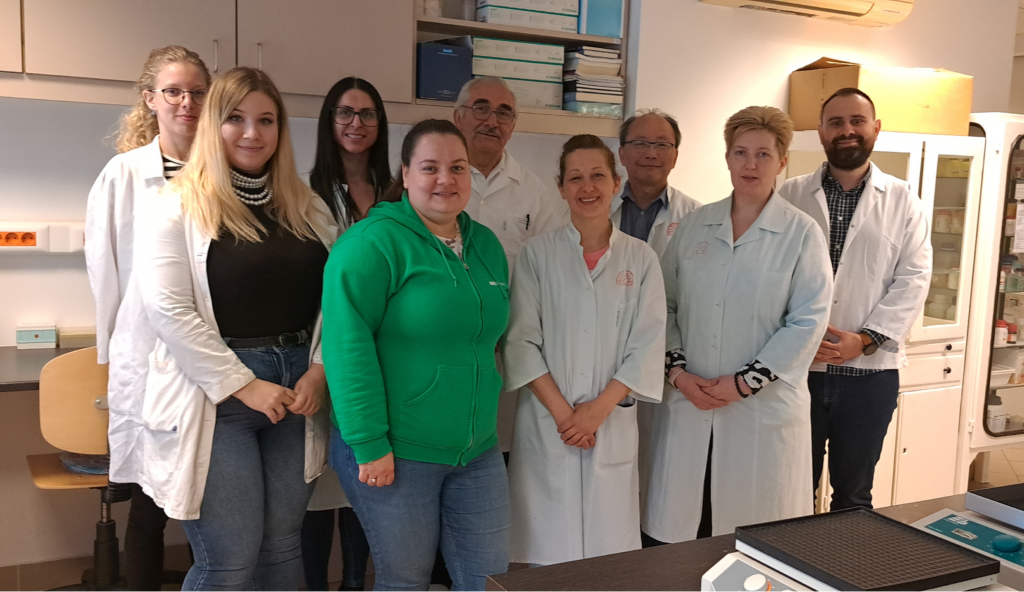Name of Researcher
LÁSZLÓ VÉCSEI
Professor of Neurology, Head of Neuroscience Research Group

Amount of support
42 977 844 Ft
Brief Description of Research
- Scientific background
The HUN-REN-SZTE Neuroscience Research Group focuses on the metabolism of tryptophan (Trp). We are specifically interested in mapping the metabolites of the kynurenine pathway (KP) and their therapeutic applications in nervous system pathologies, primarily in multiple sclerosis (MS), Parkinson’s disease (PD), and migraine. The most significant Trp degradation cascade is KP, which produces a variety of neuroactive (both protective and toxic) compounds that play important roles in the central nervous system. Kynurenic acid (KYNA) is particularly important because it regulates the function of multiple receptors, including NMDA, AMPA, GPR35, aryl hydrocarbon, and opiate in a concentration-dependent manner. Pathological changes in KYNA can contribute to the development of neurodegenerative and neuropsychiatric diseases by disrupting neurotransmitter balance. Thus, regulating the concentrations of certain metabolites, as well as synthesizing new KYNA analogues, can be used to treat a variety of neurological diseases
Dowload
- Basic research
- The characterization of knock-out (KO) mice with mutations affecting specific KP enzymes aids in the detailed exploration of the metabolic cascade and the understanding of KP’s role in nervous system organization and disease. For our joint research project, Prof. Etsuro Ono’s group at Kyushu University in Fukuoka, Japan, provided these transgenic mice.
- The study of the mitochondrial toxin model of MS, cuprizone (CPZ)-induced demyelination in mice to investigate the relationships between KP metabolites and known biomarkers of the disease contributes to a better understanding of the disease’s pathomechanism and the role of KP in MS
Drug research
- The research network at SZTE ÁOK, GYTK, TTIK, and SZBK aims to develop water-soluble, biologically accessible derivatives that can penetrate the blood-brain barrier better than KYNA. Our goal is to conduct pharmacological testing on these substances as well as technological developments such as drug carriers in the colloidal size range, nano/micrometer, biologically compatible and degradable systems, and micelle encapsulation, to assist in the delivery of the compounds to their intended target.
- Detailed mapping of the pharmacodynamic and pharmacokinetic properties of KYNA derivatives.
- KYNA analogues’ behavioral and neurochemical effects in Japanese KO mice, experimental pain and migraine, MS and PD animal models, and correlations with known disease biomarkers.
- Clinical biomarker research
- Identification of correlations between Trp metabolites and “disease-specific” biomarkers (e.g., NFL, Neopterin, CGRP, PACAP, glial and inflammatory markers) in migraine patients treated at our clinic.
- Examining the relationship between positive or negative reactions to drugs and the levels of metabolites or biomarkers helps in studying the impact of various treatments. These patterns may be useful for distinguishing disease forms/stages, identifying their characteristics, and developing personalized medicine.
- Translational research
- Search for correlation between preclinical and clinical data, similar to previous Phase I studies (see previous collaboration with Prof. Messoud Ashina’s Copenhagen Headache Center: https://pubmed.ncbi.nlm.nih.gov/33682377/ ).
- Establishing partnerships with pharmaceutical companies to advance the development of patented molecules.




